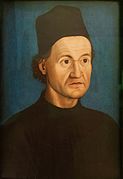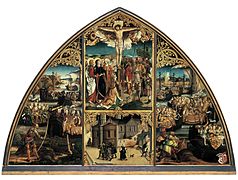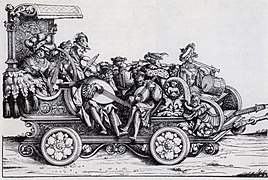Hans Burgkmair the Elder
Hans Burgkmair the Elder (* between January 1 and May 10, 1473 in Augsburg ; † between May and August 1531 there ) was an important painter , draftsman and designer for woodcuts at the beginning of the 16th century. Alongside Hans Holbein the Elder and Hans Holbein the Younger, he is considered the most important Augsburg artist between the late Gothic and Renaissance periods .
Life

The note says in capital letters:
Joann Burgkmair M [aler] 56 Jar old
Ann Allerlaiin Ge [mahe] l 52 Jar old
As the son of the painter Thoman Burgkmair (1444–1523), Hans came into contact with painting at an early age, and he learned the technique in his father's workshop. His apprenticeship took him to Colmar ( Alsace ) from 1488 to 1490 to Martin Schongauer , who had a lasting influence on him. After his return, his earliest work was the portrait of the Strasbourg cathedral preacher Johann Geiler von Kaysersberg , as well as a portrait of the Augsburg bishop Friedrich II von Zollern .
From 1491, Burgkmair worked for the Augsburg printer Erhard Ratdolt as a woodcut ripper. On July 3, 1498 he married Anna Allerlay, daughter of the furrier Jörg Allerlay. On March 29, 1498 he was accepted as a master in the guild of Augsburg painters, glaziers, carvers and goldsmiths. At the Augsburg Reichstag in 1500 he made first contacts with the German king and later Emperor Maximilian I , who soon appreciated him and in 1516 gave him a coat of arms. Between 1501 and 1504 the artist painted three of the six basilica pictures for the chapter house of the Dominican convent of St. Catherine in Augsburg .
In 1503, Burgkmair went on a journey to the Lower Rhine. In 1505 he designed a triptych for the Saxon Elector Friedrich the Wise, presumably for the castle church of Wittenberg , which shows the saints Sigismund and Sebastian on the central panel. The plague saint Rochus , as well as Christophorus and other saints appear. In 1508 he made his first color woodblock prints. Since then he has mainly devoted his work to graphic works for Emperor Maximilian I, mediated by Konrad Peutinger . From 1512 to 1518 he participated with numerous designs in the woodcut series on an imperial commission ( Theuerdank , Weißkunig , Emperor Maximilian's triumphal procession ).
In 1526, the painter bought a personal property for himself and his wife to provide for retirement . His son Hans Burgkmair the Younger (1500–1562), who together with Heinrich Vogtherr the Younger created the etchings for the “Augsburger Geschlechtbuch” (1545), did not succeed in following in his father's footsteps.
Create
Burgkmair is regarded as a pioneer of the Renaissance in Augsburg, equally as a painter and a draftsman for woodcuts. During his lifetime, the emperor and church were the most important clients for his diverse work. Inspired by Italian art, Burgkmair processed forms of the Renaissance, especially in his woodcuts, and combined them masterfully with the tradition of the late Gothic. His later paintings contain the warm color palette of Venetian painting, which is why there is speculation about trips to northern Italy (a stay in Venice in 1507 is considered to be fairly certain). His main works of altar painting were created with the Johannes altar from 1518 and the crucifixion altar from 1519, both in Munich today. In his late work, e.g. B. the mannerist -looking painting Esther before Ahasver (1528) or the Battle of Cannae (1529), which he painted for Duke Wilhelm IV, Burgkmair once again achieved the quality of his earlier creative period. Of the approximately 100 woodcuts with portraits of famous rulers (from Julius Caesar to Maximilian I) that he made for an imperial book planned by Konrad Peutinger, only 23 woodcuts have survived. The master of the Augsburg painter's portraits , previously unknown by name, was active under his influence, but hardly his pupil.
Burgkmair created some excellent altarpieces. Perhaps his most beautiful and important work is the Johannes altar from 1518.
Works (selection)
- 1490 - Johann Geiler von Kaysersberg , linden wood, 37.3 cm & × 26.5 cm, 0.5 cm each left and right, the lower edge of the painting slightly trimmed from the center to the right (Augsburg, Staatsgalerie Altdeutsche Meister , inv. 3568)
- 1490 - Friedrich II. Von Zollern , paper, glued to canvas, 37.2 cm & × 25.8 cm (paper), 38.7 cm & × 26.9 cm (canvas) (Augsburg, Staatsgalerie Altdeutsche Meister, Inv.-No 1055, loan from the municipal art collections Augsburg, inv.no.10277)
- 1498 - Jakob Fugger's wedding picture and Sibylla Artzt , private property
- around 1500 - Emperor Friedrich III. , based on a lost original from 1468 (Vienna, Kunsthistorisches Museum)
- 1501 - Basilica pictures : Basilica di S. Pietro (Augsburg, State Gallery of Old German Masters)
- 1502 - Basilica pictures: Basilica di S. Giovanni (Augsburg, State Gallery of Old German Masters)
- around 1502 - The stuff book of Emperor Maximilian I , Innsbruck
- 1504 - Basilica pictures: Basilica di S. Croce (Augsburg, State Gallery of Old German Masters)
- 1507 - Coronation of Mary (Augsburg, State Gallery of Old German Masters)
- 1509 - Maria im Rosenhag (Nuremberg, Germanisches Nationalmuseum)
- 1515 - Marginal drawings for the prayer book of Emperor Maximilian I (Besançon, library)
- 1518 - Johannes altar (middle part) "Evangelist Johannes auf Patmos" (Munich, Alte Pinakothek )
- 1519 - Crucifixion altar (Munich, Alte Pinakothek)
- 1528 - Story of Esther , softwood, 103 cm & × 156.3 cm (Munich, Alte Pinakothek; part of a history cycle for the Bavarian Duke Wilhelm IV and his wife Maria Jakobäa von Baden )
- 1529 - Defeat of the Romans at Cannae , softwood, 162 cm & × 121.5 cm (Munich, Alte Pinakothek; part of the same history cycle as the story of Esther)
- Woodcut works for Emperor Maximilian I from 1509, including genealogy , Weißkunig , Theuerdank , Triumphzug . There are Weißkunig demonstrated 137 works of the master.
- Single sheets, the Clairobscur woodcut Der Tod als Würger (1510) is well known.
Wedding picture of Jakob Fugger and Sibylla Artzt , 1498
Emperor Friedrich III. , around 1500
Honor
A bust by Hans Burgkmair the Elder. Ä. was installed in the Hall of Fame in Munich .
literature
- Alfred Woltmann : Burgkmair, Hans the Elder . In: Allgemeine Deutsche Biographie (ADB). Volume 3, Duncker & Humblot, Leipzig 1876, pp. 576-578.
- Peter Strieder : Burgkmair, Hans the Elder. In: New German Biography (NDB). Volume 3, Duncker & Humblot, Berlin 1957, ISBN 3-428-00184-2 , pp. 47-49 ( digitized version ).
- Tilman Falk : Hans Burgkmair. Studies on the life and work of the Augsburg painter.Bruckmann, Munich 1968.
- Hans Burgkmair 1473-1531. The graphic work . Exhibition catalog. Stuttgart / Augsburg 1973
- Eberhard Stiebner (Ed.), Heinz Jürgen Sauermost (Author): Masterpieces of European Art in Bavarian Museums . Munich 1983
- Gero Seelig: Burgkmair, Hans . In: General Artist Lexicon . The visual artists of all times and peoples (AKL). Volume 15, Saur, Munich a. a. 1996, ISBN 3-598-22755-8 .
- 118 woodcuts by Hans Burgkmair . Edited by Stephan Füssel . Taschen, Cologne 2003, ISBN 3-8228-2189-6
- Wolfgang Augustyn , Manuel Teget-Welz (Ed.): Hans Burgkmair - New Research. Dietmar Klinger Verlag, Passau 2018, ISBN 978-3-86328-142-7
Web links
- Literature by and about Hans Burgkmair the Elder in the catalog of the German National Library
- House of Bavarian History
- Hans Burgkmair the Elder ( Memento from October 10, 2007 in the Internet Archive )
- Works by Hans Burgkmair the Elder at Zeno.org .
Individual evidence
- ↑ a b c Gero Seelig: Burgkmair, Hans . In: General Artist Lexicon . The visual artists of all times and peoples (AKL). Volume 15, Saur, Munich a. a. 1996, ISBN 3-598-22755-8 .
- ^ Robert Vischer: Studies on art history . Bonz, Stuttgart 1886, p. 512 ( uni-heidelberg.de ).
- ↑ a b Johannesaltar: Johanns auf Patmos. (No longer available online.) In: pinakothek.de. Archived from the original on April 19, 2014 ; Retrieved September 6, 2013 . Info: The archive link was inserted automatically and has not yet been checked. Please check the original and archive link according to the instructions and then remove this notice.
- ↑ Gisela Goldberg, Bayerische Staatsgemäldesammlungen (ed.): Old German paintings. Catalog . 3. Edition. Munich 1988, p. 34 .
- ↑ Gisela Goldberg, Bayerische Staatsgemäldesammlungen (ed.): Old German paintings. Catalog . 3. Edition. Munich 1988, p. 32 . After Frank Jakupski: The painter Hans Burgkmair d. Ä. 1984 (dissertation Bochum). , P. 5f. (Page count above) it can be assumed that the portrait was created after that of Geiler, as it has a more convincing image structure than this one. As a further indication he cites the sitter's hand, since Burgkmair used the expression of the hands for most of the following pictures.
- ↑ Kurt Lochs: Studies on Upper German portrait painting of the 16th century . In: Yearbook of the State Art Collections in Baden-Württemberg . tape 4 . Deutscher Kunstverlag, Berlin / Munich 1967, p. 31-84 . , Pp. 38-41. Holes ascribes the double portrait to Hans Burgkmair. Frank Jakupski agrees: The painter Hans Burgkmair d. Ä. 1984 (dissertation Bochum). , P. 7 (number of pages above). Ernst Buchner attributed it to his father Thoman Burgkmair in 1928.
- ^ Copy based on the original Bayerische Staatsbibliothek Cod. Icon. 222 Digital version , copy urn : nbn: de: bvb: 12-bsb00020956-6 .
- ↑ Volkmar old Hanselmayer: art and history. The historical pictures of Duke Wilhelm IV of Bavaria and his wife Jacobäa. Attempt at interpretation . Gebr. Mann, Berlin 1996, ISBN 3-7861-1834-5 , p. 8 . : Dating by inscription: "MDXXVIII / IOANN BURGHMAIR / ICTOR AVGVSTAN / FACIEBAT".
- ↑ Volkmar old Hanselmayer: art and history. The historical pictures of Duke Wilhelm IV of Bavaria and his wife Jacobäa. Attempt at interpretation . Gebr. Mann, Berlin 1996, ISBN 3-7861-1834-5 , p. 8 . : Dating by inscription: “MDXXIX. IOANN. BURGKMAIR / AVGVSTANUS / FACIEBAT ”.
| personal data | |
|---|---|
| SURNAME | Burgkmair, Hans the Elder |
| BRIEF DESCRIPTION | German painter, draftsman and wood cutter |
| DATE OF BIRTH | between January 1, 1473 and May 10, 1473 |
| PLACE OF BIRTH | augsburg |
| DATE OF DEATH | between May 1531 and August 1531 |
| Place of death | augsburg |













